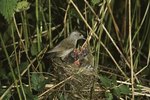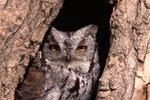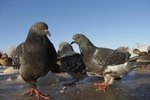
In springtime, mated doves prepare a nest where incubation takes place. The male looks for a strategic place where there's plenty of food, then invites the female to form a lifetime bond. The male and female dove cooperate in nest-building and brooding. Knowing their nesting habits may help you learn how to keep doves in your yard. Since doves are erratic birds, caution should be exercised to prevent them from abandoning the nest.
Nest Building
A male dove congregates building materials like grass weed and twigs for the female to use in building the nest. Nests are 5 to 25 feet above the ground. She makes a loose structure where eggs can fall in case the bird is startled or the object holding the nest is suddenly moved. The nest is loose-fitting enough to see through from the ground. A successful nest will be used more than once during the brooding season. In most areas, doves will use the nest for up to five broods.
You can encourage doves to set up housekeeping in your yard by providing a nesting shelf.
Incubation
After they are through building the nest, the female lays one or, more often, two eggs. She incubates at night for a period of 14 to 20 days; the male incubates during the day. Due the short incubation periods, doves are able to raise up a maximum of six broods annually. Since the male and female doves look alike, onlookers may think the female never leaves the nest at all. The male plays the main parenthood responsibilities, though -- select the site, collecting the twigs, feeding the nestlings and providing security.
Feeding
The chicks take 14 to 25 days in the nest, where both male and female doves collaborate in feeding them. In the initial stages of incubation, both birds produce pigeon milk, a milk-like substance, from the surrounding plants to feed the nestlings. The fluid contains the necessary nutrients, such as proteins that are required for quick growth, and they are fed directly from the plants by the parents. The pigeon milk is fed to the young doves for the first few days after they're hatched. For diamond doves, parents regurgitate food for the young chicks for the first two weeks after they're hatched.
Abandonment
Exercise caution while nest-watching, as doves are flighty birds. They may abandon both eggs and nestlings if they feel threatened by predators -- or curious humans -- and look for a new nesting site. Additionally, doves may abandon the nest if it's attacked by biting insects like ants, mice or lice.
References
Photo Credits
-
David De Lossy/Valueline/Getty Images
Writer Bio
Kendal Elizabeth has been a professional writer and editor since 2001. She has specialized in writing pet-related topics, home decor and gardening. Her work has appeared on several online and offline publication. Elizabeth holds a Bachelor of Science in Animal Science with a minor in marine biology from Cornell University.



